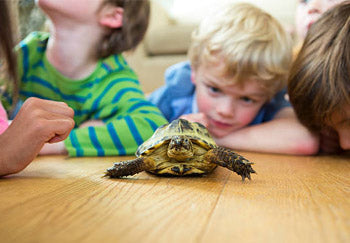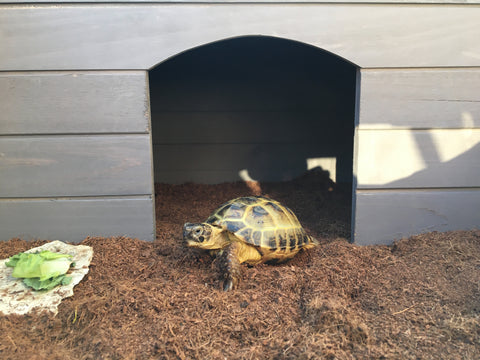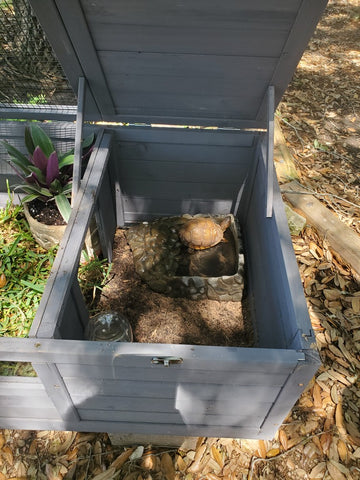How to Raise A Pet Turtle?

Abstract
If you want to choose an animal as a pet, then you can first consider a a turtle as a pet. Turtles are easier to keep than other pets. It is perfect for newbies with pets. Moreover, turtles as pets are considered to be auspicious animals, which can bring peace and longevity, and are most suitable for office workers who want to keep pets but do not have much energy to take care of them. First of all, it will not disturb your life, it will not take up too much space for you, and it will not cost you too much. This article will show you how to care for a turtle, or about pet turtle care.
Things You Should Know Before Raise A Pet Turtle

While we say a turtle as a pet is easy to keep, there are a lot of things to keep in mind for pet turtle care. Before deciding to keep a pet turtle, you should first understand the basics of pet turtles so that you can take better care of them. You should know a lot about raising turtles. Knowing the pet turtle care can cost you less energy .
Types of Pet Turtles
In the army of pets, there are not a few people who keep turtles. Many people think that turtles are a good animal to keep and don't have to be a headache to keep like other pets. There are many kinds of turtles on the market. But they don't know pet turtle care.
Due to different living environments, the types of pet turtles are divided into terrestrial turtles, aquatic turtles, semi-terrestrial turtles, marine turtles, and bottom-dwelling turtles. According to the food of turtles, it is divided into animal turtles, plant turtles, and omnivorous turtles. The more common ones are the Chinese tortoise, the Mississippi map turtle and the Brazilian tortoise.
Which turtles are better to raise and easy for pet turtle care? What kind of turtle is good for a novice? What kind of turtle is the best and beautiful? The following will take you into the world of pet turtles.
- Brazilian Pet Turtle Care
The most common thing people keep is the Brazilian tortoise. Brazilian turtles as pets are cheap and easy to get sick. Keep the water temperature at the right temperature and the water will be clean.
But you have to know that the Brazilian turtle has the habit of basking in the sun, but it cannot be exposed for a long time. Outdoor turtle cages cannot be placed in places with long-term direct sunlight, and must have shading facilities. If you keep turtles indoors, you can install a UV lamp 30 cm away from the turtle box and irradiate it for 15 to 20 minutes a day. Brazilian turtles are great for beginners to keep as pets.
- Egg Pet Turtle Care
Egg turtles are a large class of turtles that have become increasingly popular in recent years. The shape of the egg turtle is relatively unique. Its carapace is oval and very smooth. It is no different from an egg when viewed from the top down, hence the name. Egg turtles as pets are omnivorous, in addition to turtle food, you can properly feed shrimp, small fish, red nematodes, animal offal, etc.
- Flame Pet Turtle Care
The flame tortoise shell stripes are like flames, bright and bright. Its plastron is generally yellow, sometimes with red, black, and reddish-brown patterns. The adult body length of the flame turtle will be 35-45cm. It is an omnivorous animal. Animal feed can eat small fish, shrimp, tadpoles, snails, earthworms, etc. Raising turtles like this you can feed some vegetables and fruits at home such as lettuce, cabbage, etc., and can also feed turtle feed.
- Burmese Pet Turtle Care
The adult Burmese turtle is oval in shape, with a rounded carapace. Its head is yellowish green and its body is yellowish brown. Each scutellum of the Burmese turtle has irregular black patches. Burmese turtles are mainly herbivorous, but also eat animal food. Can be fed melons, fruits, vegetables, lean meat, etc., they like to eat tomatoes. Here we just introduce this breed. In fact, the Burmese tortoise is a national protected animal, and personal trading and breeding are strictly prohibited.
- Maple Pet Turtle Care
Maple turtles are among the more common turtles. This tortoise has a peculiar appearance and is easy to identify. Their carapace is long, but not wide, and the tail has many tooth-like decorations. So it looks more like a maple leaf. Maple turtles as pets are omnivores. Raising turtles like this you can feed on various insects, worms, leaves and fruits of plants, etc.
- Map Pet Turtle Care
Map turtles as pets have many unique characteristics. Most striking are the characteristic thin lines on their skin and scutellum. This is where the name "Map Turtle" comes from. Because they look like contour lines on a map. Raising turtles like this you can feed them fish, crustaceans and shellfish, chicken, liver, insects, lean meat, and more.
- Money Pet Turtle Care
The head of the money glans is slender, the back of the head is golden yellow, and the shell is reddish brown. It has 3 black vertical stripes on its body, like a "Chuan" character lying across it. This is a characteristic of every money turtle. The money turtle is an omnivorous turtle, feeding on various aquatic animals such as fish and shrimp in the wild. Sometimes they also eat a small amount of wild vegetables and wild fruits. They also like to feed on earthworms, bee pupae and animal offal. In artificial breeding, it is mainly carnivorous.
How Long Do Pet Turtles Live
Many people are curious about turtle lifespan for pet turtle care. As the saying goes, a thousand-year-old tortoise has a long life span of 80,000 years. But this is just an exaggeration. In fact, not all tortoises can live that long. If a turtle as a pet lives longer than a person, then What to do?
We just said that the Brazilian turtle is the most common turtles as pets. The average lifespan of Brazilian turtles raised by people is about 15 to 25 years. The turtle lifespan is about 50 years. The sea turtle lifespan can reach 100 to 150 years.
The types of turtles we mentioned above. Egg turtles lifespan is 10-20 years. The flame turtles lifespan is 30-50 years. Burmese turtles lifespan is 30-50 years. Map turtles lifespan is 10-20 years. Maple turtles lifespan is about 10 years. The money turtle lifespan is 30-80 years.
How to Take Care Of A Pet Turtle
Many people think that owning a pet is a time-consuming and labor-intensive thing. In fact, turtles are very tenacious and easy to raise. But once you decide to keep a turtle as a pet, then you should consider care for turtles, or how to care for a turtle, what do turtles need. And next is about pet turtle care.

What Do Pet Turtles Eat
For pet turtle care, our priority for raising turtles must be the pet turtle diet. So what do pet turtles eat? Although turtles are omnivores, they can eat any food. But feeding cheap and low nutritional value food all the time may cause malnutrition.
What do pet turtles eat? Turtles as pets need a lot of calcium and should be fed a diet rich in calcium for pet turtle care. There are nutritionally balanced tortoise-specific feeds on the market. Calcium deficiency can cause them to develop soft shell disease.
The pet turtles are generally terrapins or semi-water turtles. Although they are omnivorous animals, they basically prefer meat, and only tortoises like to eat vegetarian food. Usually, you can feed fish, shrimp, snails, mussels and other meats, but also with vegetables, otherwise it will lead to malnutrition.
Feeding Method
- Feeding time
Feeding pet turtles is generally done when the temperature is a little higher. Because the low temperature will affect its appetite, causing it to not eat. Usually the feeding time in the morning is at 8-9 o'clock. If it is a low temperature season, you can postpone the feeding time and wait until noon before feeding.
- Feeding times
Usually, pet turtles do not need to be fed too often. Because their metabolism is very slow, it is easy to not digest if fed too much. Usually, it is enough to feed them once every three to five days. In winter, the low temperature will cause it to hibernate. At this time, it will stop eating and do not need to be fed.
- Matters needing attention
Another point worth noting for pet turtle care. After the pet turtle is fed, the water should be changed every few hours. Because it will excrete after it is full, if the water is not changed in time to clean up, the water quality will deteriorate, which is not good for its health. Change the water completely, and at the same time make sure that the temperature of the new water and the old water are the same.
Choosing A Right Turtle Habitat
The more the ideal turtle habitat is restored to its natural state, the better. If you have the budget, you can directly buy a large pet turtle habitat. The turtle pet's habitat is high enough to prevent it from climbing out. And the pet turtle habitat should be square, not round. For raising turtles, try to create a breeding environment where water and land are separated.
The advantages of organizing boxes are that they are convenient, inexpensive, and can be placed anywhere. The disadvantage is poor viewing. The advantage of the glass cylinder is that it has good viewing, especially with landscaping, high specifications, but pay attention to firmness. Turtles are kings of destruction. The disadvantage is that it is difficult to take care of and expensive.
Having said that, I must mention one more thing about pet turtle care. To find an ideal turtle habitat, you need to choose an experienced turtle habitat manufacturer. Aivituvin is a kennel manufacturer with over 20 years of experience. In order to pet turtle care, you need to make serious choices. Of course, this is just my friendly advice.
Temperature of Your Small Pet Turtle Care
Keep the pet turtle's body temperature constant. You must pay attention to pet turtle cares. When kept indoors, keep the environment at 25-28 degrees Celsius and 50% humidity. Heating facilities cannot be ignored in winter. The environment should pay attention to reducing humidity, increasing temperature and strengthening light to keep warm. A small amount of UV light can help pet turtles absorb calcium.
The Importance of Water
The water quality should be kept in good condition. The quality of water quality directly affects the growth and development of pet turtles. Therefore, the water quality must be kept clean, the water must be changed every day in summer, and the harm of chemical pollutants must be prevented.
The water temperature needs to be kept around 20-30 degrees Celsius. In addition to drinking water, it also helps to remove waste from the body. Turtles often defecate in water basins. So pay attention to changing fresh water frequently. Warm water is available in winter. The water cannot be too deep. You can feed it after soaking in water. At this time, the pet turtle's appetite is the best, because the stomach has been emptied at this time.
Keep Your Pet Turtle Health
In the process of raising turtles, it is inevitable that we will make pet turtles sick due to negligence. Below we summarize several diseases caused by inadvertent care for turtles.
Gastroenteritis
The first point worth noting about pet turtle care.
Cause: The ambient temperature dropped suddenly, or the bait was not fresh or clean, or the water quality deteriorated.
Symptoms: There is mucus in the stool or the stool is soft or even watery, yellow, green or even sauce-colored. Turtles eat less food or stop eating.
Treatment: Small amounts of berberine, chloramphenicol or other human gastroenteritis drugs can be added to the feed.
Pseudomonas Aeruginosa Sepsis
The second point worth noting about pet turtle care.
Etiology: Pseudomonas aeruginosa infection through the digestive tract and wound.
Symptoms: The turtle has no appetite, eats less, vomits, and discharges yellow or brown pus-like feces.
Treatment: Streptomycin can be mixed into the feed, or soaked in streptomycin solution.
Scabies
The third point worth noting about pet turtle care.
Cause: The source of the disease is the subspecies Hydrophilic Aeromonas sp., which often exists in the water, such as the skin and intestines of turtles. The water quality deteriorates or the body surface is injured.
Symptoms: There are several white scabies the size of soybeans on the neck and limbs. The food intake gradually decreases and the response is slow.
Treatment: Keep sick turtles isolated. Squeeze out all the contents of the scabies, wipe the affected area with iodine, and apply oxytetracycline powder. Antibiotics can be mixed into the feed.
White Eye Disease
The fourth point worth noting about pet turtle care.
Cause: The stocking density is too large and the water quality is too alkaline.
Symptoms: Congestion and inflammation of the eye, swelling of the eye. The cornea and nasal mucosa are eroded due to the inflammation of the eye. The outside of the eyeball is covered by white secretions, and the eyes cannot be opened.
Treatment: Soak with nitrofurazone or nitrofurazone solution once a day for 40 minutes each time.
Nail Disease
The sixth point worth noting about pet turtle care.
Cause: After the carapace is worn, bacteria invade and cause the carapace to fester.
Symptoms: The surface of the carapace is festering, and in severe cases, holes are formed and even muscles can be seen. The sick turtle does not eat or move, and shrinks its head.
Treatment: isolate the diseased turtle, scrub the affected area with 3% hydrogen peroxide, remove the ulcerated part, and then apply potassium permanganate crystal powder directly.
In order not to make pet turtles sick and keep them healthy, we need to pay more attention to pet turtle care. Otherwise, it will be a trouble for the turtle owner and the turtle. If serious, be sure to see a veterinarian.
Other Considerations About Pet Turtle Care

1. Water Quality
Do not use tap water to raise turtles for pet turtle care. If you want to use tap water, put the tap water in the sun for 2-3 days, or sediment the tap water, and then feed it with the upper layer of water. If you are in trouble, you can buy mineral water for it.
If you are diligent, it is best to change the water every day and wash the sand for pet turtle care. Buy a filter system if you are lazy. Even then change it once a week. Frequent water changes are important for pet turtle care. Add a pinch of salt to the freshly changed water. Not too cold. Otherwise they will get a lot of sickness.
2. Pet Turtle Diet
Turtles are omnivores and love to eat meat when they are young. Can feed small fish, shrimp, liver, red worms, cockroaches, etc. Turtles generally eat in water. Turtles love to be vegetarian when they get older. They eat water plants. Feed some washed vegetables. High-quality turtle food is rich in calcium, protein, fiber, fat, vitamins A, B12, C, D3, and E. Nutritious, certainly not delicious. Turtles must think so too. Feeding should be appropriate, the turtle's digestive system is not very good. If the turtle is too small, it can be chopped by feeding too large shrimp. As for pet turtle care, take out the leftovers when they are done eating. Right, this is for pet turtle care.
3. Sunbathing
When it's warm, you can put it in the sun for about 15 minutes. This is for pet turtle care. Be careful not to be exposed to the sun! The sun is best at 9:00 in the morning and three or four in the afternoon. Regular exposure to the sun can supplement calcium and kill bacteria in the crevices of its shell.
4. Safety
If you have cats and dogs at home, you should add barbed wire to the turtle tank. Many turtles die under the claws of cats and dogs. Turtle tanks are so high that they can't climb out. Note that stepping on the stone land in the tank will not be able to climb out. When raising a few, pay attention to giving them a bath every day to prevent drought from dying for pet turtle care. Be careful not to let them fall when they climb high. Especially friends who raise turtles on the balcony, don't let them climb out and fall downstairs! It's very dangerous!
5. Hibernation
Hibernation is important for pet turtle care. When the temperature drops below 12 degrees, they begin to hibernate. In the north, it starts from the end of October to March of the next year. Newborn turtles are best not to hibernate in the first year, and sick turtles are best not to hibernate.
Final Thought
Pet turtles are quiet, easy to raise, and have strong vitality. The little head likes to shrink in the turtle shell, and the little tail wagging when moving is very cute. A turtle as a pet is a good choice for beginners, but be sure to choose a healthy turtle when purchasing.
This article has covered how to keep a pet turtle and about pet turtle care. Hope to be able to help you. All right. That's all about pet turtle care.


Leave a comment